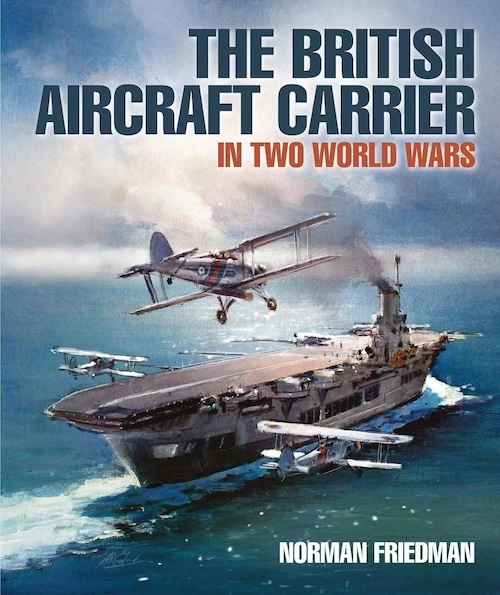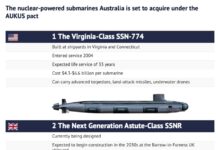
The British Aircraft Carrier in Two World Wars. By Norman Friedman. Seaforth Publishing, Barnsley, 2025. ISBN 978-1-3990-3313-8 (Hardback) ISBN 978-1-3990-3314-5 (ePub)
Reviewed by David Hobbs
Norman Friedman is a naval analyst and historian with an outstanding international reputation for his incisive books on the design and development of warships and weapons systems.
His many works include books describing US and British warships and he is well known in Australia, not least from his frequent appearances at the King-Hall naval history conferences organised by the Sea Power Centre. I have known him for many years and before going any further I should point out that I contributed a few of the photographs that appear in the book. I made no input to their captioning or any part of the text, however.
The British Aircraft Carrier is well up to the high standards set by the author in his previous books published by Seaforth and is the culmination of many years’ work at archives such as the UK National Maritime Museum collection of ship’s covers and drawings at the Brass Foundry in Woolwich. He has the ability to distil the salient details of the ships he is describing into a readable text after photographing literally thousands of pages of data. This book has the great merit, therefore, that it allows readers who cannot visit the ‘treasure-trove’ of material at Woolwich themselves to have a clear understanding of the material contained within the relevant ships’ covers at the Brass Foundry.
There are 275 pages of text with a further 25 pages of source notes and additional details; some of the latter give expanded explanations that constitute a valuable source of information in their own right. The text is complemented by more than 200 excellent black and white photographs, all carefully chosen from a variety of collections around the world, some of which are from Australian sources. The latter include a total of over 50 images contributed by Dr David Stevens, former head of the Sea Power Centre – Australia; the State Library of Victoria and Dr Josef Straczek. Beside covering RN carriers, some of which are shown in Australian waters, these include HMA Ships Sydney and Vengeance.
A considerable amount of extra detail is provided for some of the designs by the inclusion of 11 colour ‘as-fitted’ drawings copied from originals at the Brass Foundry. Three of these open out into a gatefold which is 95 cm wide to show drawings of Glorious, Ark Royal III and Victorious; the first of these in flight deck plan and the other two in side elevation. None show the Australian light fleet carrier Sydney which fits into the book’s time frame but one side view and its adjacent flight deck and island plan shows her sister ship HMCS Magnificent which was virtually identical. There are also 60 black and white drawings spread throughout the text to help the reader get a good idea of various ships’ design, construction and layout.
This is not an operational history of British aircraft carriers in the two world wars; it is a technical description of the many factors that influenced their development, design and construction although there are details of wartime damage in some cases, especially regarding the ships that were sunk. Friedman also describes carriers which underwent extensive development but which, for one reason or another, were never laid down. Examples of the latter include the 1943 Malta class fleet carriers which were eventually cancelled in late 1945 and the projected pre-war trade protection carriers. One of this book’s many strengths is the way in which the author gives concise background reasons for the development of carriers in the first place and for specific groups of carriers up to 1945. Interestingly the concepts that led to designs such as the Illustrious class with their armoured flight decks led to ships that had to operate in very different ways to those in which the Admiralty Board had imagined, especially in the air-orientated British Pacific Fleet during 1945. The impact of aircraft deck parks and comparisons with contemporary USN carriers are given the due emphasis. The impact of the Washington and London Naval treaties in the 1920s and 1930s are described at some length as are the deliberations of the Future Building Committee after 1942 which placed greater emphasis on carriers and their aircraft.
From and Australian perspective the most interesting chapter is the one describing the war programme which led to the building of 16 light fleet carriers, 3 of which went on to serve with the RAN. These were fascinating ships, among the most successful of their era, owing their origins to the perceived urgent need to get fighters to sea after the loss of the battleship Prince of Wales to Japanese naval strike aircraft in December 1941. Alternative plans to obtain such ships are explained and there is a lucid explanation of the design that was built. The changes that marked the difference between the 10 ships that became the Colossus class and the later ships that were modified to become the Magnificent class make fascinating reading. The ship launched as HMS Terrible of the latter class, the only aircraft carrier ever built in a Royal Dockyard, became HMAS Sydney. HMS Vengeance of the former class was lent to the RAN pending the delivery of the former name ship of the Magnificent class to Australia as HMAS Melbourne. Her re-design as one of the first 3 carriers to be completed with an angled deck, steam catapult and mirror landing aid is to be covered in a follow-on book by Norman Friedman which is to describe British aircraft carrier development after 1945. I look forward to it with keen anticipation.
Overall this is an important book with significant detail about carrier designs that were of direct interest to the RAN. Many of the RN carriers mentioned in the text operated in Australian waters with the excellent photograph of HMS Formidable returning Australian troops to Sydney in 1945 offering a particularly fine example on page 55. My copy now occupies a valued place in my library and I thoroughly recommend it to ANI members as an important work describing the development and design of some of the RAN’s most important warships as well as the RN ships.



